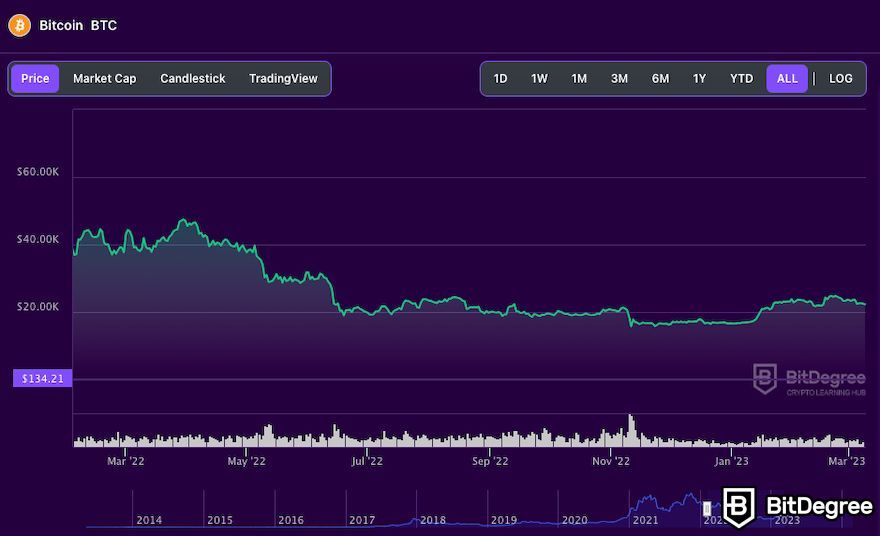Free Airdrop Season 7 is LIVE! Answer fun questions or do simple tasks to earn rewards from the $30K BitDegree prize pool. Participate Now ! 🔥
In the ever-evolving world of cryptocurrencies, where digital assets rise and fall like waves in the sea, one model has captured the attention of investors, analysts, and enthusiasts alike – the Bitcoin stock-to-flow model.
Developed by an anonymous analyst known as PlanB, this model has emerged as a promising tool for understanding the dynamics of Bitcoin's price movements and has garnered a reputation for its accuracy in predicting the cryptocurrency's future value.
Whether you're a seasoned Bitcoin investor or someone looking to understand the nuances of cryptocurrency analysis, I’m here to provide you with valuable insights into this groundbreaking paradigm shift in Bitcoin evaluation.
Just remember to always do your trading on trustworthy exchanges like Binance, Kraken, or KuCoin.

Did you know?
Subscribe - We publish new crypto explainer videos every week!
What is a Crypto Wallet? (Explained With Animation)


Table of Contents
What is Stock-to-Flow?
Before diving into the Bitcoin stock-to-flow model, we must first figure out what is stock-to-flow.
Latest Deal Active Right Now:Head to BitDegree Missions, gather as many Bits as possible & claim your stake of the $30,000 Prize Pool! Don't waste your time & start collecting Bits by completing Missions and referring friends.
You see, stock-to-flow (S2F) is not exclusive to the world of digital currencies. In fact, it's a concept that has been used in various industries and economic analyses for quite some time. So, what is stock-to-flow when it's not related to crypto?
At its core, S2F is a ratio that measures the existing stock of a certain asset relative to its annual production, or flow.
This ratio provides insights into the scarcity and value of the asset in question. To put it simply, stock refers to the amount of the asset currently available in the market, while flow represents the new supply that enters the market each year.
Let's take an example outside the realm of cryptocurrency to illustrate this concept. Imagine you're considering investing in gold. Gold has been a valuable asset throughout history, and its stock-to-flow ratio plays a crucial role in determining its market value.
The stock of gold refers to the total amount of gold already mined and available for use or investment. On the other hand, the flow represents the annual production of new gold.

When the stock-to-flow ratio of an asset like gold is high, it suggests that the asset is scarce and has limited supply relative to its annual production. This scarcity tends to drive up the value of the asset in the market.
Conversely, if the S2F ratio is low, it indicates a higher availability of the asset, potentially leading to lower market value.
The concept of stock-to-flow can be applied to other commodities as well.
Take oil, for instance. The stock of oil refers to the total reserves of oil that can be extracted and utilized, while the flow represents the annual production of new oil. By analyzing the stock-to-flow ratio of oil, experts can gauge the balance between supply and demand and make predictions about future oil prices.
It's important to note that the stock-to-flow ratio is not a standalone indicator but rather a tool used in conjunction with other factors to assess the market dynamics of a particular asset. Economists, analysts, and investors rely on this ratio to gain insights into scarcity, pricing trends, and potential investment opportunities.
By understanding the stock-to-flow ratio of various assets, one can make informed decisions about investing and assess market dynamics in different industries.
The Bitcoin Stock-to-Flow Model Explained
Now that you know what stock-to-flow is, let's break down the intricacies of the Bitcoin stock-to-flow model - in a way that is accessible and informative.
But before that, here's how the Bitcoin stock-to-flow chart looks:

Source: Glassnode Studio
So, Bitcoin, the world's most popular cryptocurrency, has garnered significant attention not only for its decentralized nature and potential to disrupt traditional financial systems but also for its unique economic model. One of the key tools used to analyze Bitcoin's value and price dynamics indeed is the stock-to-flow model.
What makes the stock-to-flow model for Bitcoin so intriguing?
Well, the key point of how this model is perceived by crypto enthusiasts is its historical correlation with Bitcoin's price movements, especially in normal market conditions.
Analysts have observed that, as the stock-to-flow ratio of Bitcoin increases over time, its price tends to follow suit. According to the model, as Bitcoin's halving events occur approximately every four years, reducing the rate of new supply by half, the stock-to-flow ratio rises significantly.
This reduction in the flow of new Bitcoin assets entering the market creates a scarcity that has historically driven up the price.
Proponents of the stock-to-flow model argue that Bitcoin's scarcity is a key driver of its long-term value proposition. They believe that Bitcoin's fixed supply of 21 million coins, combined with the gradually diminishing issuance rate, makes it comparable to precious commodities in terms of scarcity.

This viewpoint suggests that, as the stock-to-flow ratio of Bitcoin increases over time, it could potentially lead to substantial price appreciation. When checking the Bitcoin stock-to-flow chart, it's possible to see how those variables actually relate.
However, it's essential to note that the stock-to-flow model is not without its critics. Some argue that Bitcoin's value is influenced by a variety of factors beyond scarcity, such as market sentiment, adoption rates, regulatory developments, and macroeconomic conditions (and there is historical evidence to support that).
As such, these critical-thinking investors recommend caution against relying solely on the stock-to-flow model for price predictions, emphasizing the need for a comprehensive analysis that considers multiple factors.
So, to put it briefly, the Bitcoin stock-to-flow model provides an intriguing framework for analyzing the relationship between scarcity and price in the cryptocurrency market. Its historical correlation with Bitcoin's price movements in normal market conditions captivated the attention of many investors and analysts.
However, while the model offers valuable insights, it is important to approach it with a balanced perspective, considering other factors that can influence Bitcoin's value. But don’t worry, I'll help you explore the implications of the stock-to-flow model in more detail and examine its strengths and limitations for cryptocurrency analysis.
Key Factors and Variables
So, what are the key factors and variables that contribute to the effectiveness of this groundbreaking model?
Supply and Stock-to-Flow Ratio
One of the fundamental components of the S2F model obviously is the concept of supply and the stock-to-flow ratio. Supply refers to the total amount of Bitcoin currently in circulation, while the stock-to-flow ratio (Bitcoin) is a measure of new supply entering the market relative to the existing supply.
A higher stock-to-flow ratio indicates a scarcer asset and is believed to be correlated with Bitcoin's value, as you can see in the Bitcoin stock-to-flow chart.
Halving Events
Bitcoin's issuance rate undergoes a process called "halving" approximately every four years. During a halving event, the number of new Bitcoins created in each block is reduced by half.
These events are programmed into the Bitcoin protocol and are significant in the S2F model because they directly impact the supply dynamics and the stock-to-flow ratio.
Scarcity and Market Perception
Bitcoin's scarcity is a crucial element considered in the S2F model. As the stock-to-flow ratio increases due to halving events, the model suggests that Bitcoin becomes increasingly scarce, potentially leading to an increase in value.

The market perception of scarcity and the belief in the stock-to-flow model's validity play a significant role in shaping Bitcoin's price movement.
Historical Price Patterns
The stock-to-flow model leverages historical price patterns to make predictions about future price movements.
By examining the relationship between the stock-to-flow ratio and past price behavior, the model attempts to identify recurring patterns and trends. However, it's important to note that past performance is not a guarantee of future results, but historical data can provide valuable insights into potential price movements.
Market Forces and External Factors
While the stock-to-flow model focuses on the internal supply dynamics of Bitcoin, it is essential to acknowledge that external factors and market forces can influence the cryptocurrency's price.
As mentioned before, you need to keep those factors in mind. Remember that market sentiment, regulatory developments, macroeconomic conditions, and technological advancements can impact Bitcoin's value and should be considered alongside the stock-to-flow model's analysis.

To sum up, understanding the key factors and variables in the stock-to-flow model (Bitcoin) is crucial for comprehending its implications in cryptocurrency analysis.
The supply and stock-to-flow ratio, halving events, scarcity, historical price patterns, market forces, and external factors all contribute to the model’s effectiveness. By considering these elements, you can gain valuable insights into Bitcoin's potential price movements and the ever-evolving landscape of digital currencies.
Now, let's see how the stock-to-flow model has revolutionized the analysis of cryptocurrencies, and the implications it has for the crypto market as a whole.
The Importance of Stock-to-Flow in Crypto Investing
When it comes to investing in cryptocurrencies, having a solid understanding of the factors that can influence their value is crucial. In this context, the S2F model is considered particularly relevant - especially if we’re talking about the Bitcoin stock-to-flow model.
As you already know, the stock-to-flow model emphasizes the significance of scarcity in determining the value of an asset. As the asset becomes scarcer, its perceived value may increase.
The same principles apply when we’re talking about cryptocurrencies, and become particularly notorious in the context of Bitcoin.
But is the stock-to-flow model applied to other crypto?
Although the S2F model became well-known after it predicted Bitcoin's rise from late 2020 to early 2021[1], it has been applied to other cryptocurrencies, too. Some investors believe that the stock-to-flow ratio can provide valuable insights about how much a cryptocurrency might be worth in the future, based on its scarcity and how it's issued.

But it's important to remember that not everyone agrees on whether the stock-to-flow model works well for all cryptocurrencies. Different coins have different characteristics and ways of being created, so the model might not apply to all of them in the same way.
In other words, it's important to be careful. Always consider each cryptocurrency's unique features and how it works before using the stock-to-flow model.
Bitcoin, with its fixed supply of 21 million coins and increasing stock-to-flow ratio over time, presents an appealing value proposition for investors. While no model can predict the future with certainty, the S2F model has shown promising predictive power when it comes to Bitcoin's price in the past.
Historical data analysis suggests a correlation between the stock-to-flow ratio and Bitcoin's market performance. This has led some investors to use the model as a tool for making investment decisions, though it's important to exercise caution and consider other factors as well.
The stock-to-flow model emphasizes the significance of a long-term perspective in crypto investing. It suggests that short-term fluctuations in a cryptocurrency’s price might be less relevant when compared to the asset's scarcity and its stock-to-flow dynamics over extended periods.
Investors who believe in the model's validity often adopt the HODL mentality, focusing on the potential long-term value appreciation of Bitcoin.

Besides crypto enthusiasts, the stock-to-flow model has garnered attention within the wider crypto investment community. Its increasing popularity has the potential to shape cryptocurrencies’ market sentiment and influence investment decisions.
As more investors embrace the model, its predictions and implications could impact the market dynamics of many cryptocurrencies, driving traders toward the most promising digital assets.
The stock-to-flow model has emerged as a paradigm shift in cryptocurrency analysis, particularly in the context of Bitcoin. It offers a unique perspective on the relationship between scarcity and value, providing insights that can be valuable for crypto investors.
While the model is not without its criticisms and limitations, its increasing influence underscores the need to consider stock-to-flow dynamics when assessing the potential long-term value of cryptocurrencies.
By understanding the importance of stock-to-flow in crypto investing, investors can make more informed decisions and navigate the ever-evolving landscape of digital assets with more insight.
Benefits of the Bitcoin Stock-to-Flow Model
So, what are the benefits of utilizing the Bitcoin stock-to-flow model?
✓ Price Prediction Capabilities
One of the key advantages of the Bitcoin stock-to-flow model is its ability to provide enhanced price prediction capabilities, devoid of emotions and individual perceptions. After all, when analyzing cryptocurrencies’ historical data without the appropriate tools, wishful thinking can end up playing a big role.
By incorporating the scarcity of Bitcoin and its production rate, the model takes into account fundamental factors that influence the price over time. This allows investors to analyze the Bitcoin stock-to-flow chart, make more informed decisions and have a better understanding of Bitcoin's long-term price trends.
✓ Assessment of Bitcoin's Fundamental Value
The stock-to-flow model also enables a comprehensive assessment of Bitcoin's fundamental value. Considering the supply and production ratios of Bitcoin provides insights into the asset's scarcity and utility.
By comparing Bitcoin's stock-to-flow ratio to that of other assets like gold or silver, investors can evaluate its relative value and potential as a store of wealth.

Besides, Bitcoin's stock-to-flow model has gained significant attention due to its ability to predict the impact of halving events.
The model quantifies the decrease in new supply resulting from these events, offering investors confidence in Bitcoin's deflationary nature and its potential to appreciate in value over time.
✓ Contribution to Risk Management
Another advantage of the S2F model is its contribution to risk management strategies. By analyzing Bitcoin's stock-to-flow ratio and historical price movements, investors can identify potential price cycles and mitigate risk.
This allows for more informed decision-making, helping investors navigate volatile periods and reduce exposure to unnecessary losses.
✓ Validation of the Growing User Network Effects
Bitcoin's stock-to-flow model also serves as a validation of the network effects inherent in the cryptocurrency. As Bitcoin's adoption and market capitalization increase, its scarcity and stock-to-flow ratio become more pronounced.

This reinforces the notion that Bitcoin's value is driven not only by speculation but also by its growing network of users, further solidifying its position as a dominant cryptocurrency.
The Bitcoin stock-to-flow model offers a paradigm shift in cryptocurrency analysis, providing a somewhat holistic approach to understanding Bitcoin's price movements and fundamental value.
As the cryptocurrency ecosystem continues to evolve, the Bitcoin stock-to-flow model stands as a valuable tool for investors and researchers alike, contributing to a deeper understanding of this groundbreaking digital asset.
Implications and Criticisms
Okay, now it’s time to focus on the not-so-great aspects of the Bitcoin stock-to-flow model. While it has its proponents, the model is not without its implications and criticisms.
For starters, critics argue that while the stock-to-flow model has performed well in retrospect, its historical success does not guarantee future accuracy.
A great example of this occurred during 2022’s crypto winter. It started when US inflation rose to levels not seen in decades. This led the Federal Reserve to take action by raising interest rates.
As a result, investors decided to play it safe and sold off high-risk assets like cryptocurrencies and stocks. The falling prices of cryptocurrencies revealed that many crypto lenders, exchanges, and hedge funds had taken on too much risk.
In May 2022, the collapse of two well-known cryptocurrencies, Luna and TerraUSD, had a domino effect. Crypto lenders Voyager Digital and Celsius Network filed for bankruptcy protection in July 2022. They faced challenges with liquidity and mismanagement, which ultimately led to their downfall.

In November 2022, FTX encountered severe difficulties due to mismanagement and a lack of funds. This resulted in bankruptcy and the arrest of its founder, Sam Bankman-Fried. FTX, once valued at $32 billion, couldn't overcome these challenges. Just two weeks later, another crypto lender, BlockFi, also declared bankruptcy.
Amidst the chaos, the crypto market as a whole suffered a significant decline. The total market size plunged to $821.4 billion, representing a drop of over 60% from its 2021 close of $2.22 trillion.
Throughout 2022, Bitcoin witnessed a noteworthy decrease in its value, plunging from around $46,000 to around $16,000 between January and December. This decline translates to a substantial drop of nearly 65%.
In the midst of the crypto winter, the stock-to-flow model proved inadequate in accurately forecasting Bitcoin prices. Despite its projection of a Bitcoin price exceeding $100,000 in 2022, the actual market value of BTC that year fell well below this optimistic estimation.

As mentioned before, Bitcoin's price is influenced by various factors, including market sentiment, regulatory developments, technological advancements, and macroeconomic conditions. These factors may not be adequately captured by the stock-to-flow model alone.
Furthermore, the stock-to-flow model focuses primarily on scarcity as the main driver of Bitcoin's value, overlooking other fundamental aspects such as network adoption, utility, and competition from other cryptocurrencies. Critics contend that these factors play a crucial role in determining Bitcoin's long-term success and value.
It’s also fair to say that the stock-to-flow model heavily relies on historical data to make predictions about the future.
However, the cryptocurrency market is highly dynamic and subject to rapid changes, as it’s plain to see from the 2022 crypto winter example. Critics argue that relying solely on past patterns may not fully account for unforeseen events or shifts in market dynamics.

Finally, there are alternative valuation models that propose different approaches to assessing Bitcoin's value. Critics of the stock-to-flow model suggest that a comprehensive analysis should consider multiple methodologies and indicators to gain a more holistic understanding of Bitcoin's worth.
So, while the Bitcoin stock-to-flow model has gained popularity as a tool for analyzing Bitcoin's value, it’s important to remember it can’t be seen as a stand-alone tool.
The model's ability to generate price predictions, consider halving events, and support the store of value narrative are notable strengths. However, concerns over its limited scope, over-reliance on historical data, and alternative valuation models highlight the need for a cautious and comprehensive approach.
Alternative Price Valuation Models
Speaking of alternative valuation models that can be used to assess the price of Bitcoin, here is a list of a few common ones used by analysts and investors (apart from the Bitcoin stock-to-flow model, of course):
- Metcalfe's Law. Metcalfe's Law states that the value of a network is proportional to the square of the number of its users. Applied to Bitcoin, this model suggests that the value of Bitcoin is related to the square of the number of active users on the network[2].
- NVT Ratio. The Network Value to Transactions (NVT) ratio compares the market capitalization of Bitcoin to the daily on-chain transaction volume[3]. The NVT ratio is used to identify potential overvaluation or undervaluation of Bitcoin relative to its transactional activity.
- Cost of Production. This model estimates the value of Bitcoin by considering the cost of mining[4]. It takes into account factors such as electricity costs, mining hardware expenses, and operational overhead. The idea is that the cost of production should act as a lower bound for the asset's value.
- Market Sentiment Analysis. Some models attempt to gauge the sentiment and emotions of market participants by analyzing social media activity, news sentiment, and other indicators. By understanding the overall sentiment surrounding Bitcoin, analysts may attempt to predict its value[5].
Though, it's important to note that these models also have limitations, and their accuracy in predicting Bitcoin's value is widely debated. So, keep in mind that none of them should be considered stand-alone tools. Instead, you should use them all to enrich your analysis and decision-making processes!
Conclusions
The Bitcoin stock-to-flow model has emerged as a groundbreaking approach to analyzing the value and future potential of BTC. Its ability to capture the scarcity and predictability of Bitcoin's supply has revolutionized the way we perceive and evaluate this digital asset.
The model's ability to forecast future price levels based on the diminishing supply of new Bitcoin assets offers valuable guidance to investors and traders. It highlights the potential for substantial price appreciation in the coming years, reinforcing the notion that Bitcoin could serve as a viable store of value and a hedge against inflation.
However, it's important to recognize that the stock-to-flow model is not a standalone tool. Some argue that it oversimplifies the complex dynamics of the cryptocurrency market and disregards other influential factors.
In case you decide to buy Bitcoin, make sure to do so on trustworthy exchanges - like Kraken, Binance, or KuCoin.
The content published on this website is not aimed to give any kind of financial, investment, trading, or any other form of advice. BitDegree.org does not endorse or suggest you to buy, sell or hold any kind of cryptocurrency. Before making financial investment decisions, do consult your financial advisor.
Scientific References
1. T. G. Morillon, R. G. Chacon: 'Dissecting the Stock to Flow Model for Bitcoin';
2. T. Peterson: 'Metcalfe's Law as a Model for Bitcoin's Value';
3. C. M. Hafner, S. Majeri: 'Analysis of Cryptocurrency Connectedness Based on Network to Transaction Volume Ratios';
4. A. Hayes: 'A Cost of Production Model for Bitcoin';
5. I. Gurrib, F. Kamalov: 'Predicting Bitcoin Price Movements Using Sentiment Analysis: A Machine Learning Approach'.
















